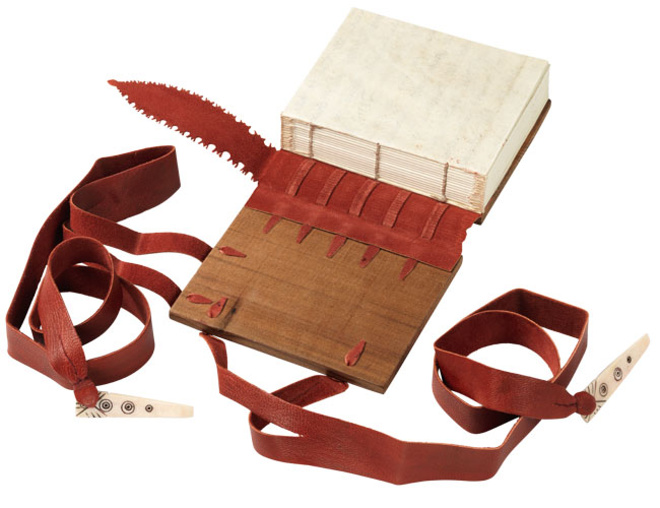From the
Exhibition:
The Codex and Crafts of Late
Antiquity
This model is a facsimile based on the Glazier Codex G. 67, a fifth-century Coptic illuminated manuscript at the Morgan Library and Museum containing the first half of the Acts of the Apostles. Creating models of historical structures of book bindings is an essential tool to gain a thorough understanding of the properties of the materials used, their role in the construction of the books, and the ways in which they affect the properties of the bindings (opening characteristics, longevity, visual appearance). This facsimile of the Glazier Codex was bound during a workshop taught by Julia Miller in New York City in 2011, which included the opportunity to view (but not handle) the original manuscript at the Pierpont Morgan Library.
The original Glazier Codex represents one of eleven known early examples of biblical texts bound in the format of a multi-gathering codex that have survived with their original bindings mostly intact. All were discovered in Egypt, written on parchment and dating from the fourth to the seventh century.1 Those that escaped destructive examination and radical conservation treatments are extremely valuable to book historians and conservators for whom knowledge of the construction of these early bindings is of great importance.
The original codex is composed of fifteen parchment gatherings of four folded leaves each, sewn together through the centerfold with thread of uncertain origin with one or possibly two needles and a link or loop stitch technique. The binding shows evidence of the existence of endbands in the holes found through the center of each of the gatherings near the head and tail, and thread fragments found in the center of some gatherings of different color (cream colored) and twist (S twist) from the sewing threads of the text block (dark brown and z twist).2
The codex was provided with two wooden boards made of Acacia wood, cut flush with the text block and beveled on all four outside edges. A strip of goatskin constitutes the spine, which was pasted to the inside joint edge of the two boards. Additionally, five goatskin slips were laced through the spine strip and through holes in the boards from the outside to the inside and also glued to the inside of the boards. The leather spine strip originally had extensions with decoratively cut edges at head and tail that served as protective covers for the top and bottom book edges. The lower extension is now missing, but the top one is still preserved in fairly good condition, although part of it is now detached.
The finished text block and cover were joined by adhering the first and last sheets of the text (there were no endpapers) to the inside of the boards, and the leather spine to the spine folds of the text block. (The leather spine is now detached, but there is evidence of adhesive residue, indicating that it was adhered to the text block at some point).3 This technique of attaching the text block to the cover was not again seen in Western bookbinding until much later, when it reappeared in machine-sewn case bindings.
Finally, two goatskin wrapping straps were attached by lacing their tapered ends through holes drilled into the front board and glueing them onto the paste-down. A strap with a bookmark attached to its end was also laced through the upper fore edge of the back board in the same fashion. Both straps of the Glazier codex are detached and incomplete but have their bone pegs. Only a small portion of the strap from the bookmark survives, however. Both the spine leather and bone pegs (on one side only) were decorated with tooled lines and concentric circles, a common Coptic decorative pattern.
The maker of this facsimile used vellum for the first and last outer folios of the text block only and paper for the rest. The codex was sewn with a link or loop stitch and one needle, and simple loop endbands were added at head and tail, based on the evidence found in the original. Goatskin was used for the spine strip, slips, and wrapping bands; deer bone was used for the bone slips that secure the wrapping bands; and oak was used for the wooden board. The model was left unfinished in the front to allow a glimpse at the sewing structure of the book (fig. 1).

Ursula Mitra is a library and archives conservator in private practice based in New York City.
1.J. Alexander Szirmai, The Archeology of Medieval Bookbinding (Ashgate, UK: 1999), 16, table 2. The books listed in this table are: 1–3: MS. 813 (Pauline Epistles, John), 814 (Acts Apostles, John) and 815 (Psalms 1–50, Matthew) at the Chester Beatty Library; 4, 5: MS. 166 (Theol. Miscellanea) and 167 (Psalms 51–151) at the University of Michigan Library; 6: Inv. 06.274 (The Four Gospels) at the Freer Gallery; 7, 8: Glazier 67 (Acts Apostles) and M. 910 (Acts Apostles - ?); 9: Scheide 144 (Matthew) at Princeton University Library; 10: Ppal.Rib.181–83 (Luke, John, Matthew) at Barcelona University Library; 11: Musil Codex (Psalms) at Cairo Coptic Museum. ↖
2.John Sharpe,
The earliest bindings with wooden board
covers. The Coptic contribution to binding construction. Postprint,
International Conference on Conservation and Restoration of Archival and
Library Materials, Erice, Sicily, April 22–29, 1996, 464.
↖
3.Paul Needham, Twelve Centuries of Bookbindings, 400–1600 (New York: Pierpont Morgan Library, 1979), 11, n. 6. ↖
